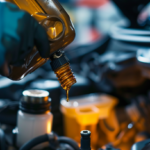Are you experiencing difficulty steering your car? You might have a power steering leak. In this article, we’ll show you how to detect and fix power steering leaks. We’ll help you identify the signs, locate the power steering fluid reservoir, inspect the hoses, and fix common causes of leaks. By the end, you’ll have the knowledge to replace power steering components and confidently test and verify your fix. Get ready to regain control of your steering!
Signs of a Power Steering Leak
If you notice fluid pooling under your car and a decrease in power steering effectiveness, you may have a power steering leak. Power steering leaks occur when there is a break or damage in the power steering system, causing the fluid to escape. One of the most common signs of a power steering leak is the presence of a puddle of fluid under your car, usually near the front wheels. This fluid is typically red or brown in color and has a distinct smell. Another indication of a power steering leak is a decrease in the effectiveness of your power steering. You may notice that it is harder to turn the steering wheel or that it feels stiff and unresponsive. If you experience these symptoms, it is important to have your power steering system checked and repaired as soon as possible to prevent further damage to your car.
Locating the Power Steering Fluid Reservoir
To locate the power steering fluid reservoir, start by checking the owner’s manual for its exact location in your specific car model. You can also look for a small plastic or metal container near the engine, usually with a cap labeled "Power Steering." Additionally, keep an eye out for common signs of a power steering leak, such as difficulty turning the steering wheel or fluid stains under the car. Once you find the reservoir, you can check the fluid level by removing the cap and using a dipstick or simply observing the markings on the reservoir itself.
Reservoir Location Tips
The first step in locating the power steering fluid reservoir is to check under the hood of your car. Open the hood and secure it with the prop rod. Once you’re there, take a look at the engine bay on the driver’s side. Look for a small plastic or metal container with a cap that has a steering wheel symbol on it. This is the power steering fluid reservoir. It is usually located near the front of the engine and is easily accessible. However, keep in mind that the exact location may vary depending on the make and model of your car. If you’re having trouble finding it, refer to your car’s owner manual for specific instructions. Once you’ve located the reservoir, you can proceed with checking the fluid level and addressing any leaks.
Common Leak Signs
Check for any visible signs of leaks around the power steering fluid reservoir, such as puddles or drips on the ground or in the engine bay. The power steering fluid reservoir is typically located near the engine, and it is a small plastic or metal container that holds the power steering fluid. Look for any wet spots or stains around the reservoir, as this may indicate a leak. You may also notice a strong smell of power steering fluid. Another common sign of a power steering leak is difficulty in turning the steering wheel. If you notice any of these signs, it is important to address the issue promptly to prevent further damage to your power steering system.
Fluid Level Check
To locate the power steering fluid reservoir on your car, simply find the small plastic or metal container near the engine. The power steering fluid reservoir is usually located on the driver’s side of the engine compartment, towards the front. It is important to note that different car models may have slightly different locations for the power steering fluid reservoir, so refer to your car’s manual for specific instructions. Once you have located the reservoir, check the fluid level by removing the cap and using a dipstick or the level markings on the side of the reservoir. The fluid level should be between the minimum and maximum marks. If the fluid level is low, add more power steering fluid until it reaches the appropriate level.
Inspecting the Power Steering Hoses
Make sure you carefully examine all the power steering hoses for any signs of leakage. Inspecting the power steering hoses is an important step in diagnosing power steering leaks. Start by visually inspecting the hoses for any visible cracks or damage. Feel along the hoses to check for any soft spots or bulges, as these could indicate a weakened area prone to leaks. Additionally, check the hose connections for any signs of fluid seepage or wetness. If you notice any leakage or damage, it is important to replace the affected hoses promptly. Remember to use gloves and safety glasses when inspecting the hoses, as power steering fluid can be corrosive. Proper inspection of the power steering hoses will help you identify and fix any potential leaks, ensuring the smooth operation of your car’s power steering system.
Fixing Common Power Steering Leak Causes
Now that you’ve identified the common causes of power steering leaks, it’s time to discuss how to fix them. By addressing the specific cause of the leak, whether it’s a worn-out seal or a damaged hose, you can prevent further leakage and maintain the proper functioning of your power steering system. In addition to fixing the current issue, it’s crucial to take preventive measures to avoid future leaks, such as regular maintenance and inspection of the power steering components.
Causes and Solutions
Are you experiencing power steering leaks due to a lack of proper maintenance? Don’t worry, there are common causes for these leaks and simple solutions to fix them. One of the main causes is a worn-out power steering pump. Over time, the seals and gaskets can deteriorate, causing leaks. The solution is to replace the pump with a new one. Another common cause is a loose or damaged power steering hose. If you notice fluid dripping from the hose, it may need to be tightened or replaced. Additionally, a leaking power steering rack can be the culprit. In this case, the rack will need to be repaired or replaced. Remember, regular maintenance, such as checking fluid levels and inspecting for leaks, can help prevent power steering issues in the future.
Preventing Future Leaks
To avoid future power steering leaks, regularly inspecting and replacing worn-out components is essential. One common cause of power steering leaks is a damaged or worn-out power steering pump. Over time, the pump can develop cracks or leaks in its seals, causing fluid to escape. To prevent this, it is important to check the power steering pump regularly for any signs of damage or leakage. Another potential cause of leaks is a worn-out power steering hose. These hoses can deteriorate over time, leading to leaks. To prevent this, inspect the hoses regularly and replace any that show signs of wear or damage. Additionally, keeping the power steering fluid at the correct level and using the recommended type of fluid can also help prevent leaks. Regular maintenance and attention to these components will go a long way in preventing power steering leaks in the future.
Replacing Power Steering Components
You can start by removing the old power steering components and replacing them with new ones. First, locate the power steering pump, which is usually located on the front of the engine. Use a wrench to loosen the bolts that secure the pump in place and remove the belt from the pulley. Next, disconnect the hoses connected to the pump, making sure to catch any fluid that may leak out. Remove the pump from its mounting bracket and replace it with the new one. Connect the hoses and tighten the bolts securely. Finally, install a new power steering belt and adjust its tension. Remember to refill the power steering fluid reservoir with the recommended type and amount of fluid.
Testing and Verifying the Power Steering Leak Fix
Before proceeding further, you’ll need to perform a thorough inspection and conduct a test to confirm that the power steering leak has been successfully fixed. Start by visually inspecting the power steering system for any signs of leakage. Look for any fresh fluid stains or wetness around the power steering pump, hoses, and connections. If you don’t see any visible leaks, you can move on to the next step. Next, start the engine and turn the steering wheel from lock to lock several times. Pay attention to any abnormal noises or resistance in the steering movement. If everything feels smooth and quiet, it’s a good indication that the leak has been fixed. Additionally, you can also check the power steering fluid level and color to ensure that it is at the proper level and free from any contaminants. By performing these tests, you can verify that the power steering leak has been successfully addressed and your car is now in good working condition.

Lucas is an experienced vehicle technician with hands-on knowledge of almost every car brand available. Throughout his career, Lucas has worked on a wide range of vehicles, including domestic and foreign models, sports cars, trucks, and SUVs.





